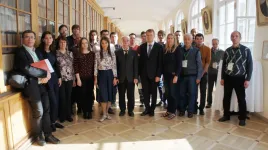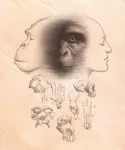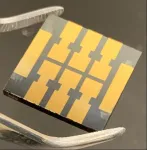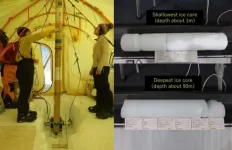INFORMATION:
The study was supported by grants from: the Deutsche Forschungsgemeinschaft (the German Research Foundation); the European Research Council (ERC); the German Academic Scholarship Foundation Studienstiftung; Westlake University in China; St Petersburg University (Russia); and other scientific institutions.
For reference
At present, Alexey Kavokin heads: the Spin Optics Laboratory of St Petersburg University; the Quantum Polaritonics group at the Russian Quantum Centre; and the International Centre for Polaritonics at the Westlake University in China. He is also a Professor at the University of Southampton (UK), where he serves as a Chair of Nanophysics and Photonics. In 2011, he won a mega-grant from the Government of the Russian Federation, as part of which the Uraltsev Spin Optics Laboratory was established.
Physicists unveil the condensation of liquid light in a semiconductor one-atom-thick
This discovery will help create new types of lasers capable of producing qubits - the main integral parts of quantum computers of the future
2021-05-06
(Press-News.org) The idea of creating quantum computers has long captured the minds of researchers and experts of IT corporations. They are the most powerful computers operating according to the laws of the quantum world and capable of solving many problems more efficiently than the most productive classical supercomputers. Similar developments are underway, for example, at Google and IBM. However, many such projects require the use of cryostats. These are vessels with liquid nitrogen or compressed helium, inside which quantum processors are cooled to temperatures below -270°C. Such a low temperature is required to maintain the superconductivity effect, which is necessary for the operation of quantum computers.
The developments of Alexey Kavokin and his colleagues are related to the creation of a polariton platform for quantum computing. One of its key advantages is the ability to perform quantum computing at room temperature. The polariton laser has been discovered by Alexey Kavokin and his colleagues. It operates on the principle of Bose-Einstein condensation of exciton polaritons at room temperature, and makes possible the creation of qubits - the basic elements of quantum computers. Qubits occur using the method of laser irradiation of artificial semiconductor structures - microcavities.
In the new study, the researchers managed to observe experimentally for the first time how a Bose-Einstein condensate is formed in the world's thinnest semiconductor - the atomically thin crystal of molybdenum diselenide (MoSe2). Bosonic condensate contains tens of thousands of quanta of 'liquid light', the exact name of which is exciton polaritons. These particles have the properties of both light and ordinary material particles, and they can be used as information carriers. This means that, instead of electrons, an electrically neutral liquid light can run through the microcircuits of any electronic device. Polariton devices will make it possible to process immense data streams at speeds close to the speed of light.
The study engaged physicists from: the University of Würzburg (Germany); the University of California Merced (USA); the Westlake University in China; Arizona State University (USA); National Institute for Materials Science (Japan); and St Petersburg University (Russia).
'The Bose-Einstein condensate was obtained in a semiconductor microcavity containing a layer of a new crystalline material - an atomically thin crystal of MoSe2. The localisation of light in such a thin layer was achieved for the first time,' said Professor Alexey Kavokin about the discovery. 'This research can lead to the invention of new types of lasers based on two-dimensional crystals, allowing the creation of qubits - quantum transistors that are at the heart of a quantum computer operating on a liquid light.'
It is important to understand, as Alexey Kavokin has repeatedly noted, that quantum computers are now referred to as the atomic bomb of the 21st century. This is because they open up tremendous opportunities not only in the field of, for example, the creation of new drugs, but also in the field of cyberattacks. Having such a powerful computer, it is possible to crack almost any code. Consequently, scientists today are also facing an important challenge of protecting quantum devices - quantum cryptography. This is where the discoveries of Alexey Kavokin and his colleagues are also of great importance.
ELSE PRESS RELEASES FROM THIS DATE:
Dinosaurs that hunted in the dark
2021-05-06
Today's 10,000 species of birds live in virtually every habitat on Earth, but only a handful have adaptations enabling them to hunt active prey in the dark of night. Scientists have long wondered whether theropod dinosaurs - the group that gave rise to modern birds - had similar sensory adaptations.
A new study led by University of the Witwatersrand scientist, Professor Jonah Choiniere, sought to investigate how vision and hearing abilities of dinosaurs and birds compared. The international team of researchers used CT scanning and detailed measurements to collect information ...
What can a dinosaur's inner ear tell us? Just listen
2021-05-06
New Haven, Conn. -- If paleontologists had a wish list, it would almost certainly include insights into two particular phenomena: how dinosaurs interacted with each other and how they began to fly.
The problem is, using fossils to deduce such behavior is a tricky business. But a new, Yale-led study offers a promising entry point -- the inner ear of an ancient reptile.
According to the study, the shape of the inner ear offers reliable signs as to whether an animal soared gracefully through the air, flew only fitfully, walked on the ground, or sometimes went swimming. In some cases, the inner ear even indicates whether ...
Rooted tree key to understanding bacterial evolution, new study suggests
2021-05-06
The findings, published in the journal Science today, demonstrate how integrating vertical descent and horizontal gene transfer can be used to infer the root of the bacterial tree and the nature of the last bacterial common ancestor.
Bacteria comprise a very diverse domain of single-celled organisms that can be found almost everywhere on Earth. All Bacteria are related and derive from a common ancestral Bacterial cell. Until now, the shape of the bacterial tree of life and the placement of its root has been contested, but is necessary to shed light on the early evolution of life on our ...
Evading the uncertainty principle in quantum physics
2021-05-06
The uncertainty principle, first introduced by Werner Heisenberg in the late 1920's, is a fundamental concept of quantum mechanics. In the quantum world, particles like the electrons that power all electrical product can also behave like waves. As a result, particles cannot have a well-defined position and momentum simultaneously. For instance, measuring the momentum of a particle leads to a disturbance of position, and therefore the position cannot be precisely defined.
In recent research, published in Science, a team led by Prof. Mika Sillanpää at Aalto University in Finland has shown that there is a way to get around ...
Review: Most human origins stories are not compatible with known fossils
2021-05-06
In the 150 years since Charles Darwin speculated that humans originated in Africa, the number of species in the human family tree has exploded, but so has the level of dispute concerning early human evolution. Fossil apes are often at the center of the debate, with some scientists dismissing their importance to the origins of the human lineage (the "hominins"), and others conferring them starring evolutionary roles. A new review out on May 7 in the journal Science looks at the major discoveries in hominin origins since Darwin's works and argues that fossil apes can inform us about essential aspects of ape and human evolution, including the nature ...
'Molecular glue' makes perovskite solar cells dramatically more reliable over time
2021-05-06
PROVIDENCE, R.I. [Brown University] -- A research team from Brown University has made a major step toward improving the long-term reliability of perovskite solar cells, an emerging clean energy technology. In a study to be published on Friday, May 7 in the journal Science, the team demonstrates a "molecular glue" that keeps a key interface inside cells from degrading. The treatment dramatically increases cells' stability and reliability over time, while also improving the efficiency with which they convert sunlight into electricity.
"There have been great strides ...
Hollings researchers study SARS-CoV-2 antibodies in asymptomatic & symptomatic individuals
2021-05-06
MUSC Hollings Cancer Center researchers added to the understanding of the protective immune response against the SARS-CoV-2 virus in a study published in April in iScience. The team found that approximately 3% of the population is asymptomatic, which means that their bodies can get rid of the virus without developing signs of illness.
The researchers screened more than 60,000 blood samples from symptomless individuals in the Southeastern U.S., including Georgia, South Carolina and North Carolina, for the IgG antibody to the viral spike protein.
What began as a highly collaborative statewide effort to detect SARS-CoV-2 accurately, ...
Kidney cancer risks higher for Hispanic, Native Americans in Arizona
2021-05-06
Recently published research from the University of Arizona Health Sciences shows that advanced-stage kidney cancer is more common in Hispanic Americans and Native Americans than in non-Hispanic whites, and that both Hispanic Americans and Native Americans in Arizona have an increased risk of mortality from the disease.
"We knew from our past research that Hispanic Americans and Native Americans have a heavier burden of kidney cancer than non-Hispanic whites," said Ken Batai, PhD, a Cancer Prevention and Control Program research member at the UArizona Cancer Center and research assistant professor of urology in the College of Medicine - Tucson. "But we also know that around 90% of the Hispanic population in Arizona is Mexican American - either U.S.-born or Mexican-born ...
Ice core data show why, despite lower sulfur emissions in US and Western Europe, air pollution is
2021-05-06
The air in the United States and Western Europe is much cleaner than even a decade ago. Low-sulfur gasoline standards and regulations on power plants have successfully cut sulfate concentrations in the air, reducing the fine particulate matter that harms human health and cleaning up the environmental hazard of acid rain.
Despite these successes, sulfate levels in the atmosphere have declined more slowly than sulfur dioxide emissions, especially in wintertime. This unexpected phenomenon suggests sulfur dioxide emission reductions are less efficient than expected for cutting sulfate aerosols. A new study led by Tokyo Institute of Technology (Tokyo Tech), Hokkaido University and the University ...
Protected by nanobrushes
2021-05-06
The ability of antibodies to recognize specific cancer cells is used in oncology to specifically target those cells with small active agents. Research published in the journal Angewandte Chemie shows that scientists have now built a transport system that delivers even large protein-based drugs into cancer cells. This study demonstrates how proteins can arrive at their target intact, protected from destructive proteases by polymer brushes.
Developing anticancer treatments involves two recurring problems for researchers. An active agent needs to be able to kill the body's cells at the root of the cancer, and it should be active in target cancer cells rather than in healthy cells. Many medical researchers ...
LAST 30 PRESS RELEASES:
A researcher’s long quest leads to a smart composite breakthrough
Urban wild bees act as “microbial sensors” of city health.
New study finds where you live affects recovery after a hip fracture
Forecasting the impact of fully automated vehicle adoption on US road traffic injuries
Alcohol-related hospitalizations from 2016 to 2022
Semaglutide and hospitalizations in patients with obesity and established cardiovascular disease
Researchers ‘listen in’ to embryo-mother interactions during implantation using a culture system replicating the womb lining
How changing your diet could help save the world
How to make AI truly scalable and reliable for real-time traffic assignment?
Beyond fragmented markets: A new framework for efficient and stable ride-pooling
Can shape priors make road perception more reliable for autonomous driving?
AI tracks nearly 100 years of aging research, revealing key trends and gaps
Innovative techniques enable Italy’s first imaging of individual trapped atoms
KIER successfully develops Korea-made “calibration thermoelectric module” for measuring thermoelectric device performance
Diversifying US Midwest farming for stability and resilience
Emphasizing immigrants’ deservingness shifts attitudes
Japanese eels, climate change, and river temperature
Pusan National University researchers discover faster, smarter heat treatment for lightweight magnesium metals
China’s 2024 Gastroenterology Report: marked progress in endoscopy quality and disease management
Pusan National University researchers uncover scalable method for ultrahigh-resolution quantum dot displays
Researchers use robotics to find potential new antibiotic among hundreds of metal complexes
Gut bacteria changes at the earliest stages of inflammatory bowel disease
Scientists develop new way to “listen in” on the brain’s hidden language
Brain research: “Pulse generators” grow and shrink as memories are formed
For teens, any cannabis use may have impact on emotional health, academic performance
School meals could unlock major gains for human and planetary health
Menopause hormone therapy does not appear to impact dementia risk
Signature patterns of brain activity may help predict recovery from traumatic brain injury
Dresden study uncovers new key mechanism in cancer cells
New species are now being discovered faster than ever before, study suggests
[Press-News.org] Physicists unveil the condensation of liquid light in a semiconductor one-atom-thickThis discovery will help create new types of lasers capable of producing qubits - the main integral parts of quantum computers of the future







